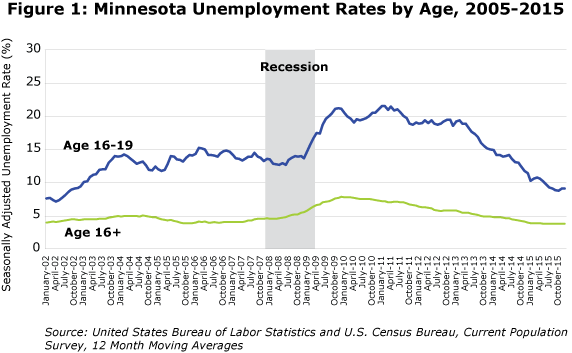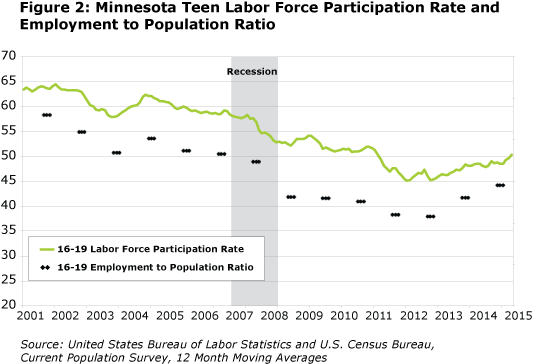by Nick Dobbins
March 2016
The youngest members of Minnesota’s workforce are approaching their debut. As the school year ends and summer begins, teenagers turn their attention towards potential jobs as retail clerks, lifeguards, and fast food restaurant employees to earn their first paychecks and begin their working lives. Whether it’s students taking advantage of their time off to earn some extra pocket money or recent high-school graduates looking for their first ever full-time job as they enter the adult world, this is the time of year when many of Minnesota’s teenagers make their official entrance into the labor market.
In the years following the recession unemployment rates for young workers spiked. Not only were jobs harder to come by for all demographics, but many older, more experienced workers were forced into entry-level positions which previously may have gone to teenagers. However, that situation has since turned around completely. As Figure 1 illustrates, in recent years the labor market in Minnesota has recovered to the point that unemployment is no longer the serious issue it once was with rates for 16 to 19 year olds falling below 10 percent last year. By the end of 2015 the unemployment rate for this age group reached its lowest point since the summer of 2002, well before the recession hit in 2007. This trend coincides with a wider labor force tightening in the state. Unemployment for all workers in Minnesota reached 3 percent in late 2015, the lowest rate in 15 years.1 More than at any other time in recent years, Minnesota teens who wanted a job in 2015 were able to find one, a sign that healthy market figures should carry over into the summer of 2016.

While unemployment rates are important for understanding a labor market, looking at labor force participation for that particular market as well provides a much more complete picture as the two can exert influence on each other. For example, if having a job became less desirable for teens and large numbers of them decided they didn’t want to work, more jobs would be available than there would be teens to fill them, and it’s likely that unemployment rates would drop. But that would be less indicative of a high demand for teenaged employees, and more indicative of a shifting supply and demand relationship. However, this does not appear to be the reason for our recent decline in unemployment rates among 16-19 year olds.
Nationally labor force participation among teens plateaued and began a slow if steady decline in the 1970s. This decline became even more precipitous over the past decade plus. In Minnesota the labor force participation rate for 16 to 19 year-olds plummeted from 63.5 percent at the end of 2001 to 45.1 percent at the end of 2012.2 That trend is mirrored at the national level with more and more young people choosing to enter the workforce later in life as they pursued higher education in greater numbers. However, the past couple of years have brought a marked departure from the trend of declining participation among young people. As Figure 2 illustrates, Minnesota youths’ participation in the labor market has been steadily increasing since 2013, a rather dramatic change from the long-term trend of declining participation.

In 2014 Minnesota instituted a widely-publicized increase in the minimum wage. The first changes to our minimum wage went into effect in August of 2014, when it rose from $6.15 an hour ($5.25 for smaller companies) to $8.00 ($6.50 for smaller companies). That was the first phase of the new law, and increases continue through 2016 when the large-employer minimum will settle at $9.50 per hour.
Because teenagers lack the knowledge and experience of older workers, they are more likely to find themselves in entry-level positions as they join the workforce. Consequently, they are also more likely than the general population to find themselves working in jobs that pay the minimum allowable wage. A DEED analysis done in 2013 showed that in the previous year, jobs paying less than the new minimum wage were most concentrated in one of two industries: Accommodation and Food Service, in which 58.5 percent of jobs would be affected by Minnesota’s new minimum, and Retail Trade, where 44.1 percent of jobs would be affected.3 Unsurprisingly, those two industries employ a disproportionate number of 16 to 19 year-old workers.
When looking at the spike in labor force participation among teens, it is tempting to conclude that there is a direct cause-and-effect relationship with the recent wage hike, although there are also other possible explanations including the low unemployment rate for all workers in the state and the generally tight labor market as well as Minnesota teens’ history of labor force participation, which is traditionally much higher than elsewhere in the country as we will explore next. However, given the low unemployment rate and high participation rates for teen workers, this new higher wage floor does not seem to be making it exceedingly difficult for them to find summer jobs so far.
As mentioned previously, Minnesota’s teens are much more likely to be active members of the workforce than their counterparts across the country. As Figure 3 shows, summer participation in the labor market is much higher in Minnesota than in the rest of the United States. Likewise, we have seen a distinct uptick in participation since 2013, while U.S. participation rates have remained largely flat.

This high participation rate is not unique to Minnesota, however. In fact, while we had the second highest labor force participation rate for 16 to 19 year olds in the country in 2014, most of the other top rates occurred among our neighboring Midwestern states suggesting a possible broader cultural reason for the disparity.
Nine of the top 10 states for teen labor force participation also have above average labor force participation rates for all employees with Maine as the sole outlier. The national labor force participation rate for all employees in 2014 was 63.3 percent, 6.4 percentage points lower than Minnesota’s rate. The difference between Minnesota and the nation is even more pronounced among 16 to 19 year-olds, where Minnesota’s 53.4 percent participation is 15.8 percentage points higher than the national rate of 37.6 percent. Likewise, of the 10 states with the lowest teen labor force participation rates, eight of them have below average rates for the entire population.
| Table 1: Top Ten States for Teen Labor Force Participation Rate, 2014 | ||||
|---|---|---|---|---|
| State | 16-19 LFP | 16-19 Rank | 16+ LFP | 16+ Rank |
| South Dakota | 56.5% | 1 | 69.6% | 4 |
| Minnesota | 53.4% | 2 | 69.7% | 3 |
| Nebraska | 51.1% | 3 | 70.3% | 1 |
| Iowa | 50.8% | 4 | 67.8% | 11 |
| Wisconsin | 50.4% | 5 | 66.9% | 15 |
| New Hampshire | 48.6% | 6 | 68.0% | 10 |
| Maine | 48.5% | 7 | 63.1% | 32 |
| Utah | 48.2% | 8 | 67.6% | 12 |
| North Dakota | 47.8% | 9 | 69.4% | 5 |
| Kansas | 47.4% | 10 | 66.0% | 19 |
| Source: U.S. Census Bureau - American Community Survey, 2014 1-year estimates | ||||
Summer jobs offer young Minnesotans a chance to learn the basic job skills that employers will look for as the teens move forward in their careers. For young people who aren't pursuing additional education, they represent their first full-time job, and the vital income and experience that come with it. These early jobs help teens develop connections with employers, bolster their resumes for future job and college applications, and begin to understand the working world, setting the foundation for adult life as productive citizens of Minnesota.
There are a number of organizations in the state that strive to help young Minnesotans find suitable jobs. Many have a specific focus, such as sales, environmental stewardship, or carpentry. In addition to the programs listed below, DEED provides avenues of assistance for people who come from low income families or have other barriers to employment. The MN Youth Program, Youthbuild Program, and Workforce Investment Act Youth Programs all provide services to young job seekers. You can find more information on these programs, including searchable lists of service providers.
If you're a young person, or really anyone who is looking to join the workforce, you can improve your chances by having a well written resume that is proofread by at least one additional person, finding as many references as possible from people you know already in the workforce, and being sure to pursue whatever opportunities you're able to find. Finding the right job now could have positive effects through the rest of your working life.
Selected Minnesota Youth Employment Programs and ServicesThis is a partial list of Minnesota youth employment programs and services. Many available opportunities are not listed here so please do your own research on what may be available in your community. Cookie Cart: bakery operations (paid), career readiness, workforce skills, and customer service, North Minneapolis
Elpis Enterprises: woodworking, screen printing, and experiential workshops, St. Paul EMERGE StreetWerks: summer employment program and youth services, Minneapolis Minnesota Conservation Corps: environmental services, statewide
Minnesota Landscape Arboretum, Urban Garden Youth Employment: entrepreneurship and leadership jobs in a variety of programs for youth age 12 to 19, Metro
Right Track: paid internships and career development opportunities for low-income students, St. Paul
Tree Trust Youth Summer Employment Program: paid work in a variety of positions in the Twin Cities metro area Youth Express: Saint Paul area program that includes a 15-session "Urban Apprentice" class and paid internship opportunities at a bike shop or clothing store Youth Farm & Market Project: personal development and farming, Minneapolis and St. Paul YouthLead: services for low-income Ramsey County youth ages 14-21. Includes skill training and employment opportunities. |
1United States Bureau of Labor Statistics, Local Area Unemployment Statistics
2United States Bureau of Labor Statistics and U.S. Census Bureau. 2015 Current Population Survey, 12-month moving averages
3Minnesota Department of Employment and Economic Development, December 2013 "Minnesota's Low-Wage Sector" Oriane Casale and Mustapha Hammida, Minnesota Economic Trends.